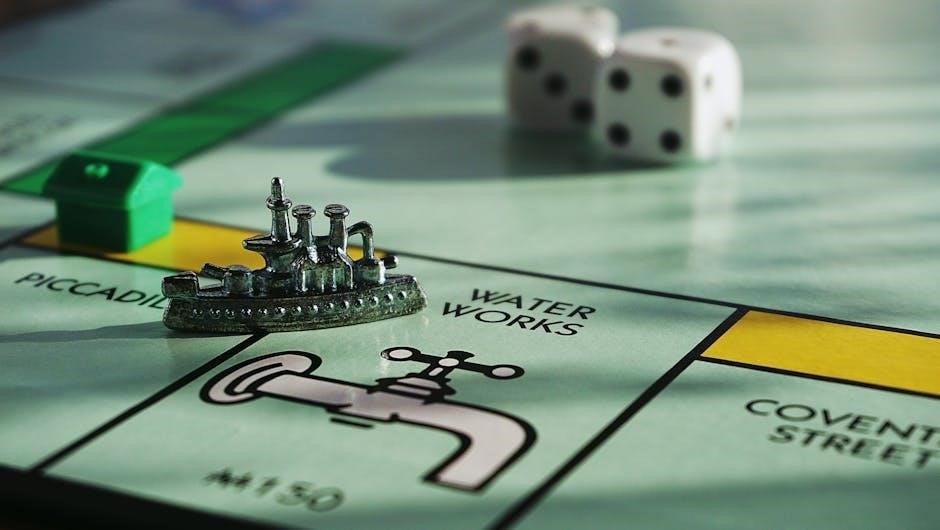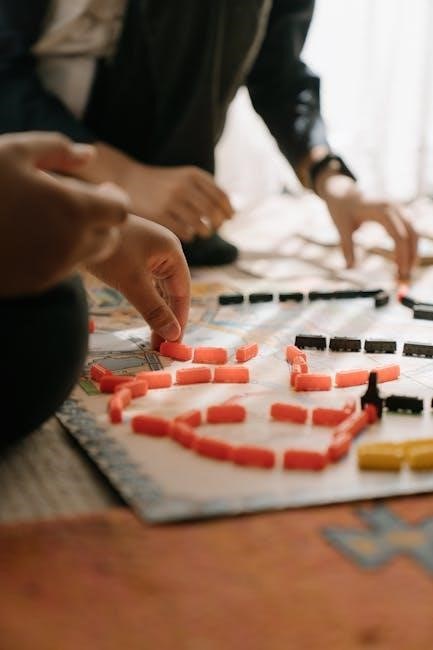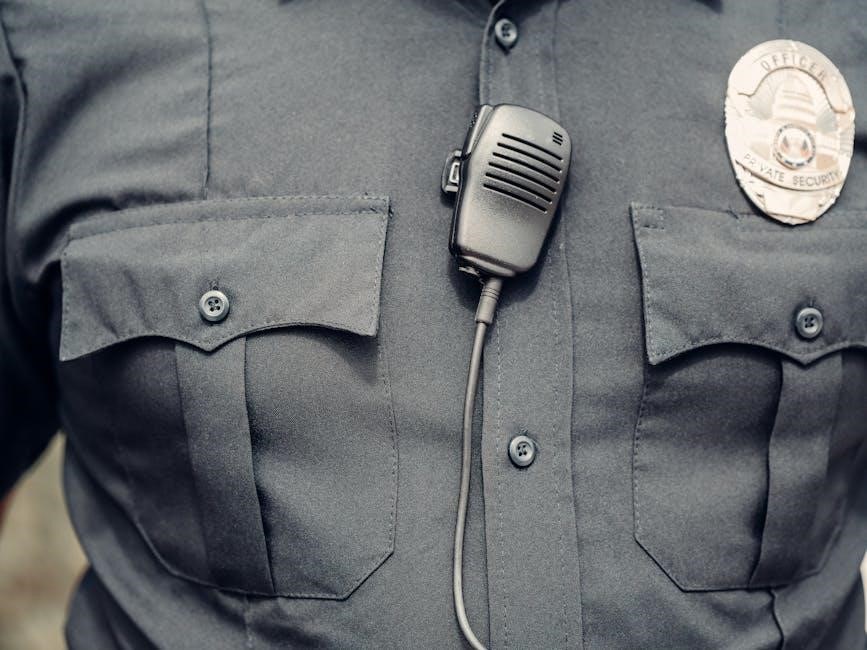Bocce is an ancient Italian game of precision and strategy, played with large balls on a court. Official rules govern gameplay, ensuring fair and structured competition. Bocce is popular worldwide, with standardized regulations available in PDF formats for easy access and understanding.
What is Bocce?
Bocce is a traditional Italian game of precision and strategy, played with large balls on a court. It involves rolling balls toward a smaller target ball, aiming for proximity. Official rules outline gameplay, emphasizing fair play and structured competition. Bocce is enjoyed globally, with variations adapting to different cultures. The game fosters social interaction and skill development. Its simplicity makes it accessible, while its depth appeals to competitive players. Bocce rules PDFs provide detailed guidelines, ensuring consistency across all levels of play, from casual to professional.
Brief History of Bocce
Bocce, an ancient game of Italian origin, traces its roots to Egypt and Rome, where similar ball-tossing games were played. It evolved through the Middle Ages, becoming popular in Europe. By the 19th century, Bocce spread globally, with standardized official rules emerging. The game’s simplicity and social nature made it accessible to all classes. Today, Bocce is enjoyed worldwide, with its rich history preserved in Bocce rules PDF guides, ensuring the tradition continues for future generations. Its enduring appeal lies in its timeless blend of skill and camaraderie.
Popularity of Bocce Worldwide
Bocce is a globally enjoyed sport, with a strong following in Europe, the Americas, and Australia. Its simplicity and social nature make it accessible to all ages. Official Bocce rules PDF downloads have further boosted its popularity, allowing players worldwide to understand and adopt standardized gameplay. The sport’s adaptability to various settings, from casual backyard games to competitive leagues, has contributed to its widespread appeal. Easy-to-share rulebooks ensure consistency, fostering a united global community of players.

Official Bocce Rules
Official Bocce rules outline the game’s structure, including equipment, field setup, and gameplay mechanics. These rules ensure consistency and fairness, available in PDF formats for reference.
Equipment Required
The game of Bocce requires specific equipment to ensure proper gameplay. Official rules specify the use of eight large balls, typically divided into two colors for team play, and one smaller target ball, known as the pallino. The balls must meet size and weight standards outlined in official guides. A measuring device, such as a tape measure, is essential for determining distances and scoring. The court dimensions and surface type are also defined in official Bocce regulations, ensuring consistency across all games. Proper equipment is vital for a fair and enjoyable experience.
The Playing Field
The playing field for bocce is typically rectangular, measuring 60 to 90 feet long and 10 to 13 feet wide. Official rules specify that the surface should be smooth, such as dirt, gravel, or synthetic material. The field is divided by a centerline, with foul lines marked at each end. Players must release the ball before crossing the foul line. The surface’s consistency and markings ensure fair play, as outlined in bocce rules PDF guides. Proper field setup is essential for accurate gameplay and adherence to regulations.
Setup and Preparation
Setting up a Bocce game involves preparing the playing field according to official rules. The field is typically 60-80 meters long and 8-13 meters wide, with center and foul lines marked. Players or officials ensure the surface is smooth and free of obstacles. The umpire oversees the setup, measuring and placing the pallino (small target ball) correctly. Teams agree on the starting player, usually determined by a coin toss. Balls are arranged in their respective positions, and the game begins with the first roll of the pallino.
Basic Gameplay Mechanics
Bocce involves rolling large balls toward a smaller target ball, called the jack. Players take turns throwing their balls, aiming to get them closer to the jack than their opponents’. The game begins with a toss of the jack, and teams alternate throws. Scoring is based on the proximity of balls to the jack, with points awarded for each ball closer than the opponent’s nearest ball. The official rules ensure structured and fair play, making it essential to follow guidelines from Bocce rules PDF for accurate gameplay mechanics.
Scoring in Bocce
Scoring in Bocce is determined by the proximity of balls to the target. Officials use measuring tools to ensure accurate point calculations, adhering to official rules.
How Points Are Calculated
In Bocce, points are scored based on the proximity of a team’s balls to the target ball, or pallino. After all balls are thrown, the distance from each ball to the pallino is measured. The team with the closest ball earns points equal to the number of their balls that are closer than the opponent’s closest ball. If a ball is exactly the same distance as the opponent’s, no points are awarded for that ball. Measurements are taken using official tools to ensure accuracy and fairness in scoring.
Scoring Techniques
Scoring techniques in Bocce involve precise measurement and strategic ball placement. Players aim to position their balls closer to the target ball (pallino) than their opponents’. Measuring tools are used to determine distances accurately. Techniques include knocking opponents’ balls out of scoring position or strategically placing balls to maximize points. Understanding these methods is crucial for mastering the game, as outlined in official Bocce rules PDF guides. Proper execution of these techniques ensures fair and competitive gameplay, adhering to standardized regulations.
Special Scoring Rules
In Bocce, special scoring rules address unique situations. If the pallino is knocked out of play, the frame is replayed. Officials measure distances to determine closest balls. Ties result in no points awarded. Special rules ensure fairness, such as when a player has no balls remaining. These rules, outlined in Bocce rules PDFs, prevent disputes and maintain game integrity. Proper understanding of these exceptions is crucial for accurate scoring and competitive play.
Penalties and Violations
In Bocce, penalties occur for rule breaches like illegal ball placement or interference. Officials enforce these penalties, ensuring fair play and adherence to the game’s standards.
Common Penalties in Bocce
In Bocce, penalties are enforced by officials to ensure fair play. Common penalties include illegal ball movements, such as touching or moving the pallino or another ball illegally. Time violations, where a player exceeds the time limit for throwing, also result in penalties. Interfering with the playing field or distracting opponents can lead to penalties. These infractions often result in points being awarded to the opposing team or even disqualification in severe cases. Officials strictly enforce these rules to maintain the integrity of the game.
Handling Violations
Violations in Bocce are addressed by officials to ensure fair play. Officials are authorized to enforce rules, measure distances, and resolve disputes. If a violation occurs, such as moving a ball illegally, the official assesses the situation and applies appropriate penalties. Players must respect rulings to maintain the game’s integrity. Disputes are resolved through formal procedures, ensuring transparency and fairness. Proper handling of violations upholds the sport’s standards and promotes a positive, competitive environment for all participants.
Disputes and Resolutions
Disputes in Bocce often arise from scoring disagreements or rule interpretations. Officials, such as umpires, are authorized to resolve these issues. Their decisions are final and binding to ensure fair play. Players should familiarize themselves with official Bocce rules PDFs to understand proper dispute resolution processes. Open communication and respect for the rules help maintain a smooth game flow. Resolving conflicts promptly prevents delays and promotes sportsmanship among participants.

Advanced Bocce Strategies
Advanced strategies involve mastering ball placement, blocking, and team coordination. Official rules in PDFs provide insights into refining techniques for competitive play and enhancing gameplay effectiveness.
Mastering Ball Placement
Mastering ball placement is crucial in Bocce, requiring precision and strategy. Players must aim for the jack while outmaneuvering opponents. Experienced players use spin and angle techniques to position their balls effectively. Understanding the court terrain and wind conditions can significantly impact placement accuracy. Practicing ball release and follow-through helps achieve consistent results. Advanced strategies involve blocking opponents’ paths or deflecting their balls. Proper placement can lead to higher scores and a competitive edge in the game.
Blocking and Deflection Techniques
Blocking and deflection are advanced strategies in Bocce, where players position their balls to hinder opponents’ shots. Blocking involves placing a ball in the path of an opponent’s potential throw, while deflection uses angles to alter the trajectory of incoming balls. These techniques require precise ball placement and a deep understanding of the court layout. Masters of these tactics can significantly influence the game’s outcome, making them essential skills for competitive play. Proper execution of these strategies can turn the tide in favor of a player or team.
Team Coordination Strategies

Effective team coordination is crucial in bocce, requiring clear communication and strategic planning. Players must assign roles, such as throwers and sweepers, to maximize efficiency. Hand signals and verbal cues help teammates align tactics. Practicing drills enhances timing and ball placement accuracy. Adapting strategies based on opponents’ moves ensures competitive edge. Official rules emphasize teamwork, making coordination essential for success. Strong coordination fosters trust and improves overall performance, leading to victory in both casual and competitive games.
Bocce Rules for Different Formats

Singles vs. Doubles
Team Play Rules
Bocce rules vary across singles, doubles, and team formats, with specific guidelines for each. Official Bocce rules PDFs detail these variations, ensuring clarity for players of all levels.
Singles vs. Doubles
In Bocce, players can compete in singles or doubles formats. Singles involve one player per team, focusing on individual skill and strategy. Doubles feature two players per team, emphasizing coordination and teamwork. Official rules in PDFs outline specific guidelines for both formats, ensuring balanced gameplay. Singles games are faster-paced, while doubles require tactical communication. Understanding these differences is crucial for adapting to various playing scenarios, as outlined in the Bocce rules PDF.
Team Play Rules
In team play, bocce typically involves 2, 4, or 8 players divided into opposing sides. Teams take turns rolling balls toward the target pallino. Each player has a specific role, with strategies often focusing on coordination and communication. The team with the ball closest to the pallino scores points. Official rules outline rotation of play and ball placement. Teams must adhere to time limits and conduct themselves respectfully. For detailed guidelines, refer to the bocce rules PDF, which provides comprehensive instructions on team dynamics and gameplay procedures.
Recreational vs. Competitive Play
Recreational bocce emphasizes fun and social interaction, often with relaxed rules. Competitive play adheres strictly to official rules, focusing on precision and strategy. While recreational games may vary in setup, competitive matches follow standardized regulations, including specific ball measurements and court dimensions. Bocce rules PDFs provide detailed guidelines for both formats, ensuring clarity for players. Understanding these distinctions helps participants enjoy the game appropriately, whether casually or in organized tournaments.
The Role of Officials in Bocce
Officials in Bocce are authorized to enforce rules, manage gameplay, and resolve disputes. They ensure fair play and maintain the integrity of the game according to official standards.
Duties of the Umpire
The umpire in Bocce is an official responsible for enforcing rules, ensuring fair play, and maintaining order during the game. Their primary duties include measuring distances to determine scoring, resolving disputes, and applying penalties. The umpire must remain impartial, making decisions based on official guidelines. They also manage game flow, ensuring adherence to time limits and proper ball placement. Their role is crucial for maintaining the integrity and enjoyment of the game, as outlined in official Bocce rules PDF documents.
Measuring and Scoring Tools
In Bocce, accurate measurement is crucial for determining scores. Official tools include a measuring tape or a specialized device to gauge distances between balls. These tools ensure fairness and precision, especially when balls are close to the pallino. Umpires rely on these instruments to make impartial decisions. Proper use of measuring tools is outlined in Bocce rules PDFs, emphasizing their role in maintaining the integrity of the game. They are essential for resolving disputes and ensuring accurate score calculation.
Official Rules Enforcement
Officials ensure adherence to Bocce rules, maintaining fair play and order. They interpret regulations, measure distances, and resolve disputes. Official rules are enforced to guarantee consistency, with decisions made in accordance with authorized guidelines. Officials are trained to apply rules impartially, using tools like measuring devices. Their role is crucial for maintaining the integrity of the game, ensuring all players follow the standardized regulations outlined in official Bocce rules PDFs. Proper enforcement fosters a competitive yet respectful environment, aligning with the game’s traditional and modern formats.

Bocce Etiquette and Sportsmanship
Respect among players is essential. Shaking hands pre-game and congratulating opponents post-game fosters camaraderie. Honest scoring and fair play are expected. Sportsmanship enhances the game’s enjoyment for all.
Pre-Game Rituals
Before starting a Bocce game, players often engage in pre-game rituals to ensure a smooth and respectful match. This includes welcoming participants, introducing officials, and briefly reviewing key rules. Officials, as defined by their duties, oversee these rituals to maintain order. Players may also inspect the court and balls, while captains or team leaders finalize strategies. These practices foster sportsmanship and clarity, aligning with the official rules outlined in Bocce rulebooks or PDF guides. Such rituals are essential for a fair and enjoyable game.
Player Conduct During the Game
Players must maintain respect and sportsmanship during Bocce games. Official rules emphasize fair play, prohibiting unsportsmanlike behavior. Participants should follow all instructions from officials, ensuring smooth gameplay. Disputes must be resolved calmly, adhering to established protocols. Proper conduct fosters a positive environment, essential for enjoyable competition. Adhering to these guidelines ensures adherence to the Bocce rules PDF, promoting a respectful and organized game for all involved.
Post-Game Practices

After the game concludes, players typically engage in courteous gestures, such as congratulating the winning team. Official practices include reviewing the final score and ensuring all rules were followed. Equipment is then collected and stored properly. Sportsmanship is emphasized, fostering a positive environment. These practices ensure a respectful and orderly conclusion to the game, aligning with the formal nature of Bocce as outlined in official guidelines.

Variations of Bocce
Bocce has traditional and modern variations, with regional differences in rules and gameplay. Official PDFs detail these variations, ensuring consistency across different formats and locations globally.
Traditional vs. Modern Variations
Traditional Bocce, rooted in Italian culture, emphasizes basic rules and casual play, often on natural terrain. Modern variations incorporate standardized regulations, advanced techniques, and official equipment. Traditional games focus on simplicity, while modern versions prioritize precision and competitive play. Official PDF guides detail these differences, ensuring clarity for players. Modern adaptations have introduced new strategies and scoring systems, making the game more accessible and structured globally. These variations cater to both recreational and competitive enthusiasts, preserving the essence while evolving with contemporary standards.
Regional Rules Differences
Regional variations in Bocce rules exist due to cultural and historical influences. Official PDF guides highlight these differences, ensuring players adapt to local standards. For example, some areas modify ball sizes or court dimensions, while others alter scoring systems. These variations are documented in official Bocce rulebooks, providing clarity for players in different regions. Understanding these differences is crucial for competitive play, as they can significantly impact gameplay and strategy. Regional rules are often refined to suit local preferences, making each area’s Bocce experience unique.
Indoor vs. Outdoor Play
Bocce can be played both indoors and outdoors, with specific rules adapting to each environment. Outdoor games often use natural surfaces like grass or dirt, while indoor courts feature synthetic materials. The playing field dimensions may vary slightly, but the core rules remain consistent. Indoor play eliminates weather-related challenges, offering a controlled setting. Outdoor play, however, provides a traditional experience with natural elements. Both formats require adherence to official Bocce rules, ensuring fair and enjoyable gameplay regardless of the venue.
- Surface types affect ball roll and strategy.
- Indoor courts often have smoother, more consistent surfaces.
- Outdoor play may involve uneven terrain and weather conditions.


Resources for Learning Bocce Rules
Official Bocce rulebooks and PDF guides provide comprehensive insights into gameplay, scoring, and penalties. Online tutorials and forums offer practical tips, while communities share expert advice for mastering the sport.
Official Bocce Rulebooks
Official Bocce rulebooks are authoritative guides outlining the game’s regulations, ensuring consistency across all levels of play. These documents, often available as Bocce rules PDFs, detail equipment specs, field setup, and gameplay mechanics. They also cover scoring systems, penalties, and dispute resolutions. Official rulebooks are published by governing bodies like the World Bocce Association and national federations. Players and organizers rely on these resources to maintain fair and structured competitions. Accessing these PDFs is essential for understanding and adhering to the game’s official standards.
Online Tutorials and Guides
Online tutorials and guides provide comprehensive insights into bocce rules, offering step-by-step explanations and visual demonstrations. Platforms like YouTube and dedicated bocce websites feature video guides that cover basic gameplay, scoring, and advanced strategies. These resources are ideal for both beginners and experienced players seeking to refine their skills. Many official bocce organizations also publish downloadable PDF guides, ensuring easy access to standardized rules. By leveraging these digital tools, players can gain a deeper understanding of the game and improve their performance effectively.
Bocce Communities and Forums
Bocce communities and forums are vibrant spaces where players share knowledge, strategies, and passion for the game. These platforms often provide access to official Bocce rules PDFs, enabling players to download and study regulations. Members discuss gameplay, equipment, and tournaments, fostering a sense of camaraderie. Many forums host Q&A sessions, where experienced players clarify rules and offer tips. Joining these communities is an excellent way to connect with enthusiasts, learn from experts, and stay updated on the latest developments in Bocce. Popular platforms include Facebook groups and Reddit forums dedicated to the sport.
Common Mistakes to Avoid
Common mistakes in Bocce include misunderstanding scoring rules, which can lead to incorrect point calculations. Incorrect ball placement is another error, affecting game fairness. Ignoring penalties disrupts play and may result in unfair advantages.
Misunderstanding Scoring Rules
Misunderstanding scoring rules is a common mistake in Bocce, often leading to disputes. Players may miscalculate points by incorrectly measuring distances or ignoring special rules. This can result in unfair outcomes and prolonged arguments. Official Bocce rules PDFs provide clear guidelines to avoid such errors, ensuring accurate scoring and smooth gameplay. Referring to these resources helps players grasp the nuances of point calculation and application, preventing misunderstandings during matches.
Incorrect Ball Placement
Incorrect ball placement is a common mistake in Bocce, often leading to penalties or disqualification. Players must ensure balls are thrown within the court boundaries and not interfere with existing balls. Misplacement can disrupt gameplay and affect scoring accuracy. Understanding official rules, such as proper throwing techniques and boundary guidelines, is crucial. Referencing official Bocce rules PDFs can help players avoid such errors and improve their game performance. Correct placement is essential for fair and enjoyable play.
Ignoring Penalties
Ignoring penalties in Bocce can lead to unfair advantages and disrupt the game’s integrity. Officials enforce rules to maintain fairness, and disregarding their decisions can result in penalties or disqualification. Failing to address violations, such as illegal ball placement or interference, undermines the game’s structure. Players must acknowledge and respect penalties to ensure smooth gameplay and maintain sportsmanship. Ignoring these rules can escalate disputes and hinder the enjoyment of the game for all participants. Adhering to penalties is crucial for a balanced and competitive match.
Bocce Rules PDF Downloads
Official Bocce rules are available in downloadable PDF formats from recognized sources like sports federations. These documents outline gameplay, equipment, and scoring for easy reference and sharing.
Where to Find Official PDFs
Official Bocce rules PDFs are available through recognized governing bodies like the World Bocce Association or the U.S. Bocce Federation. These organizations provide downloadable resources on their websites. Additionally, the International Bocce Federation and local Bocce clubs often share official rulebooks in PDF format. Players can also find these documents on official sports websites or through Bocce communities. Always verify the source to ensure the PDFs are up-to-date and authorized by governing bodies.
Key Sections to Review
When exploring Bocce rules PDFs, focus on essential sections like equipment specifications, field setup, and gameplay mechanics. These documents outline official standards for ball sizes, court dimensions, and scoring systems. Pay attention to penalty rules and dispute resolutions to ensure fair play. Additionally, review sections on player conduct and etiquette, as they are crucial for maintaining a respectful and enjoyable game environment. These guides provide clarity on both recreational and competitive play, making them indispensable for players of all skill levels.
Printing and Sharing the Rules
Official Bocce rules PDFs are easily accessible online, allowing players to print and share them conveniently. Ensure the PDF is the latest version for accuracy. Print on standard paper for clear readability. Share digitally via email or social media for widespread access. Physical copies can be distributed at events or practices. This ensures everyone is aligned with the same regulations, promoting consistency and fairness in gameplay. Printing and sharing the rules fosters a well-informed and organized Bocce community.
